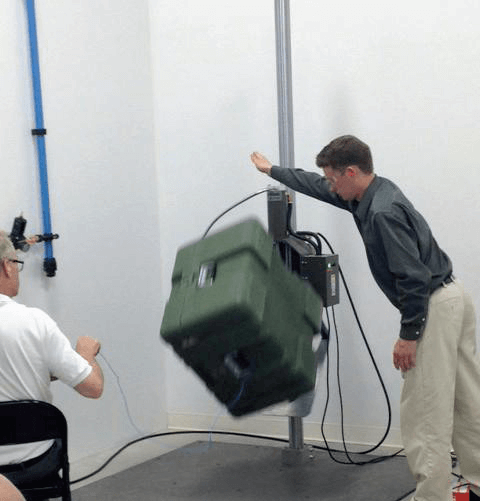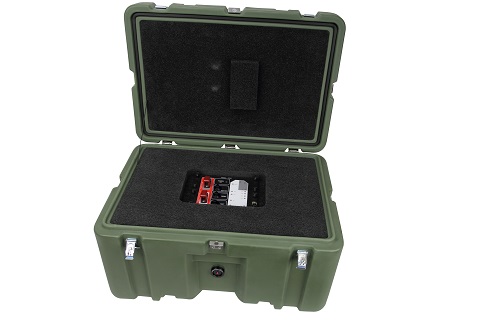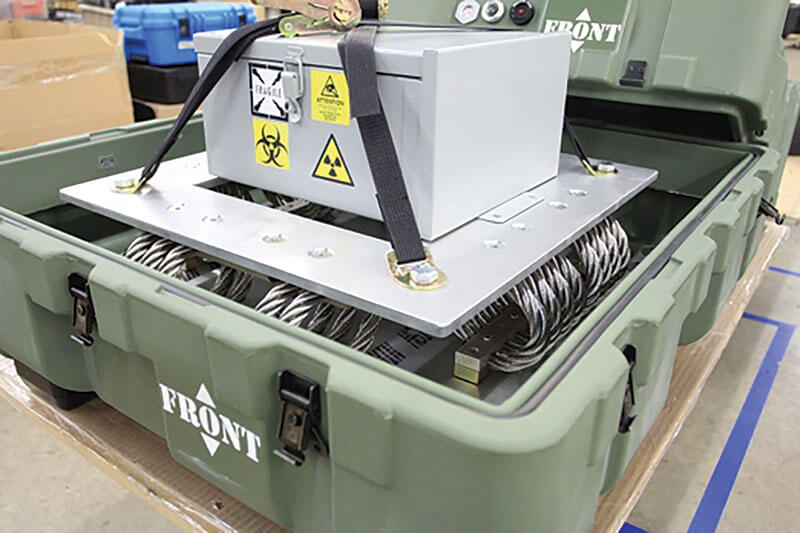
Navigating Protection Packaging Standards
There are multiple design and testing standards to address the design and validation testing of a hard sided case. Having a base understanding of these standards will aid in the design of any reusable packaging project, as well as establishing validation testing needed to prove out performance after the package is deployed. The following is a summary of several of the most commonly recognized agency and industry test and design standards that are relevant to hard sided plastic cases.
Military Standards – MIL-STD
Military Standards, or MIL-STD, are engineering requirements, design criteria, and testing methods approved by the U.S. Department of Defense in order to meet their objectives for protective packaging. These standards are numerous and cover a variety of test and design criteria. Everything from drop test heights and impact surfaces to carrying weight limits per person, even per hand, are covered.
Two commonly cited standards pertaining to plastic cases are MIL-STD-810 Environmental Engineering Considerations and Laboratory Tests, which is broad in scope, and MIL-STD-3010 Test Procedure for Packaging Materials and Containers, which is specific only to validation testing.
ASTM
These are a series of test parameters established by the American Society for Testing and Materials, an organization that works to establish criteria for quality assurance in construction and performance across a wide variety of industries and applications. These tests are the the industry standard for case testing. They have much overlap to test-specific MIL-STDs. Several ASTM most common for case testing are: ASTM D4169 Performance Testing of Shipping Containers and Systems; ASTM D6179 Rough Handling of Unitized Loads and Large Shipping Containers; ASTM D951 Water Resistance of Shipping Containers by Spray Method; ASTM D5276 Drop Test of Loaded Containers by Free Fall; and ASTM D999 Vibration Testing of Shipping Containers; ASTM D880 Impact Testing for Shipping Containers and Systems.
IP – International / Ingress Protection Rating

Immersion Test
The International Protection/Ingress Protection Rating, or IP, was drafted by the International Electrotechnical Commission (IEC), and the American National Standards Institute for classifying electrical enclosures. It describes the level of moisture and particulate protection of a container. Not specifically a packaging standard, it is commonly used to identify how a package protects against environmental conditions. The rating takes the form of “IP” plus two numbers. The first number rates solids; the second number rates moisture. A case classified as IP-67 is “airtight” and “watertight.”
| SOLID LEVEL | SOLID PROTECTION | MOISTURE LEVEL | MOISTURE PROTECTION |
|---|---|---|---|
| 0 | Non-protected | 0 | Non-protected |
| 1 | Solid foreign objects of 50 mm Ø and greater | 1 | Vertically falling water drops |
| 2 | Solid foreign objects of 12.5 mm Ø and greater | 2 | Vertically falling water drops when enclosure is tilted up to 15° |
| 3 | Solid foreign objects of 2.5 mm Ø and greater |
3 | Spraying water |
| 4 | Solid foreign objects of 1.0 mm Ø and greater |
4 | Splashing water |
| 5 | Dust-protected | 5 | Water jets |
| 6 | Dust-tight | 6 | Powerful water jets |
| 7 | Temporary immersion in water | ||
| 8 | Continuous immersion in water |
STANAG 4280/AEPP-3D
STANAG 4280/AEPP-3 is a set of packaging validation standards composed as a “standard agreement” as approved by the North Atlantic Treaty Organization (NATO). Test parameters covered include those for mechanical handling, inclined impact, free fall impact, rolling impact, container leaks, and immersion. These tests are less common than others. They are brought up here in part to highlight their overlap with other standards. As example, here is a partial list comparing AEPP-3 test methods to those comparable in MILSTD-3010 Test Procedures for Packaging Materials:
| NATO AEPP-3 TEST METHOD | MIL-STD-3010 TEST METHOD | COMPARISON |
|---|---|---|
| A - Stacking | 5017 - Superimposed Load | Duration is different |
| C - Drop | 5007 - Free Fall Drop Test | Drop quantity is different |
| D - Corner-wise Drop | 5005 - Corner-wise Drop | Equivalent |
| E - Edge-wise Drop | 5008 - Edge-wise Drop | Equivalent |
| H - Rolling | 5014 - Rollover Test | Equivalent |
| J - Horizontal Impact | 5023 - Incline Impact | Equivalent |
| P - Vibration | 5019 - Repetitive Shock | Duration is different |
| R - Leaks in container | 5009 - Leaks in container | Equivalent |
| S - Water Immersion | 5009 - Immersion included | Duration is different |
Commercial Air Transportation Standards – ATA Specification 300

Vibration Test
ATA Specifi cation 300 is a protective packaging standard put forth by the Air Transport Association, now known as Airlines for America, to establish that a package is sufficiently durable for airplane travel. There are three categories:
Category I – Reusable for a minimum of 100 round-trips
Category II – Reusable for a minimum of 10 round-trips
Category III – Usable for a minimum of 1 trip
The testing methods for each category vary due to the difference in a package life cycle. Hard sided plastic case are typically classified as Category I.
Crossover or redundancy among the multiple standards is common. ATA 300 avoids this by explicitly referencing another standard for vibration testing – specifically referencing ASTM D-999, Procedural Method B, as the requirement for vibration testing for Category I containers. As opposed to crossover, some standards simply do not cover all areas. ATA 300 Category I containers are required to be “resistant to normal precipitation.”
Gemstar Custom Hard Cases are capable of being manufactured to:
- MIL-STD-3010 Test Procedures for Packaging Materials and Containers
- FED-STD-101 Test Procedure for Packaging Material ATA Specification 300, Category I
- ASTM D4169
- IP67 – IEC Standard 60529
- MIL-STD 810
- ASTM D999 – Vibration
- ASTM D6179
- ASTM D5276
- STANAG 4280/AEPP-3 Standard Packaging Test Procedures
- ISTA Test Procedure 1A



